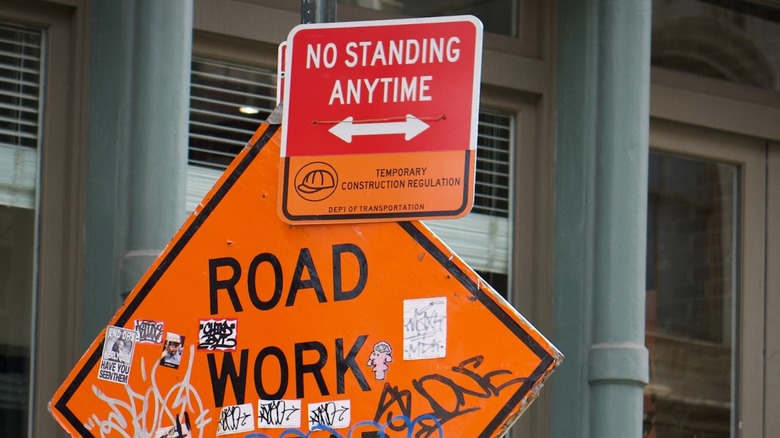What Do 'No Standing' Signs Mean, And Are They Different From 'No Parking?'
While they may be far from the most confusing traffic signs out there, you may have seen "No Standing" signs while passing by a bus stop, airport, or arena and wondered what exactly they meant. It's clear that the authorities don't want any kind of loitering in those areas for whatever reason. But isn't that what "No Parking" is for? Does "No Standing" literally mean that no one is allowed to stand or park there?
Contrary to common sense, "No Standing" doesn't mean a person can't stand in a location or a car can't stop there at all. It's really just a stricter version of "No Parking" that prohibits loading and unloading goods. The only time a driver is allowed to stop in a "No Standing" zone is to quickly drop off or pick up passengers, but waiting isn't allowed. "No Parking," on the other hand, lets drivers drop off passengers and load and unload goods, but they can't park and leave the car in the area.
For example, you'll typically find "No Parking" signs near fire hydrants, busy streets, crosswalks, or driveways. You should pay close attention because you could get towed for parking in front of someone's driveway — or other places where parking is prohibited. What all these places have in common is that traffic flow and sightlines are important for safety or convenience. However, you'll often find "No Standing" signs at airport curbsides, bus stops, taxi stands, or public buildings. These places need to be clear for easier access or better security, and the authorities don't want anybody blocking access unless they're briefly picking up or dropping off people.
Why the difference matters for drivers
On the surface, "No Parking" and "No Standing" might feel like small variations of the same rule, but the distinction can hit your wallet if you're not paying attention. Cities often treat "No Standing" violations more seriously, since those zones are in areas where traffic needs to stay fluid, like airport pickup lanes or busy transit stops. In New York City, you can get slapped with a $115 fine for violating a "No Standing" order, whereas a fine for violating "No Parking" is $60-$65. In Boston, the fine is $90 for both offenses, but the late penalty is $18 for "No Parking" and $25 for "No Standing." It makes sense because a driver who lingers even for a minute in one of those spots can cause backups that ripple through an entire block.
Enforcement isn't uniform across the country. New York City posts thousands of "No Standing" signs and aggressively tickets violators, while California uses color-coded curbs. A red curb in Los Angeles is the same as a "No Parking," "No Standing," or "No Stopping" sign; yellow curbs indicate commercial loading only, and white curbs mean that cars can load or unload passengers for a maximum of five minutes. This patchwork means drivers need to understand local laws and read signs carefully wherever they go. Confuse "No Parking" with "No Standing," and what you thought was a harmless stop could easily become an expensive fine.

